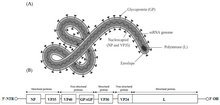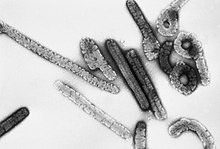The family Filoviridae (/ˌfaɪloʊˈvɪrɪdiː/),[1] a member of the order Mononegavirales, is the taxonomic home of several related viruses (filoviruses or filovirids) that form filamentous infectious viral particles (virions) and encode their genome in the form of single-stranded negative-sense RNA.[2] Two members of the family that are commonly known are Ebola virus and Marburg virus. Both viruses, and some of their lesser known relatives, cause severe disease in humans and nonhuman primates in the form of viral hemorrhagic fevers.[3] All filoviruses are Select Agents,[4] World Health Organization Risk Group 4 Pathogens (requiring Biosafety Level 4-equivalent containment),[5] National Institutes of Health/National Institute of Allergy and Infectious Diseases Category A Priority Pathogens,[6] Centers for Disease Control and Prevention Category A Bioterrorism Agents,[7] and listed as Biological Agents for Export Control by the Australia Group.[8]
| Filoviridae | |
|---|---|
 | |
| Ebolavirus structure and genome | |
 | |
| Electron micrograph of Marburg virus |
No comments:
Post a Comment